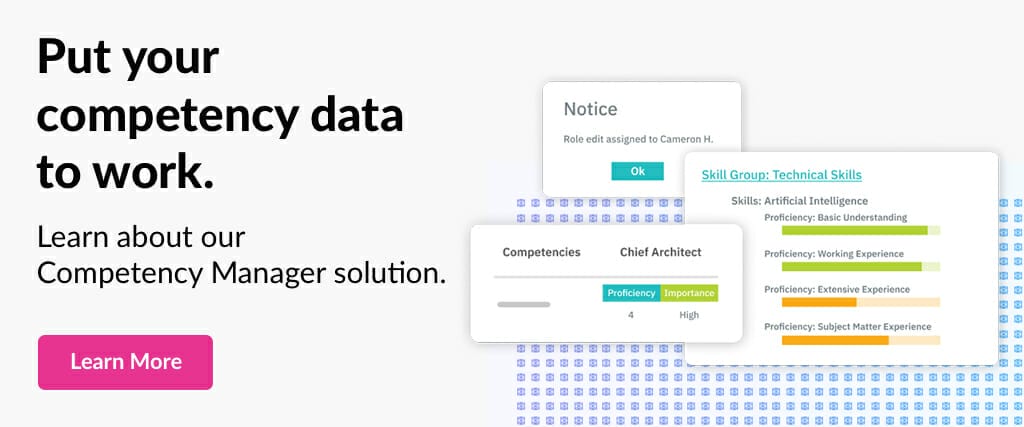How to Solve Manufacturing Skills-Based Challenges

While the chaos of the pandemic affected all industries, manufacturing may have been one of the most directly impacted. Extreme supply chain issues affected cost, timing, production, and labor in such a substantial way that many companies were scared they wouldn’t be able to recover. The expectation for the aftermath of the pandemic was that companies would rush to recoup lost profits, but instead we see manufacturing leaders taking a future based mindset to prioritize safeguarding their organizations. According to Alithya’s 2021 Manufacturing Trends Report, 57% of industry leaders stated that overall growth is their number one priority moving forward. While organizations may define growth in different ways such as facility expansion or inventory increase, at the center of growth is always the people who make up your organization. External growth comes from your internal investment in your people and the skills that they utilize every day. Three common talent problems manufacturing companies are facing right now are identifying and closing skill gaps, increasing employee retention, and creating a plan for the next wave of retirees. Let’s look into these challenges a little deeper and explore some solutions.
Challenge: Skill Gaps
Skill gaps can occur after technological or organizational shifts, of which the manufacturing industry has had many in recent years alone. Samuel’s Group cites that since the pandemic, more than half of US manufacturers have had a major problem finding qualified candidates. Unemployment has remained high over the past few years and many individuals are still looking for work. However, the increase in technology has caused there to be a gap for people seeking jobs and the skills needed to fulfill the current roles available. It is estimated that by the year 2025, 2 million to 3.5 million manufacturing positions will be unoccupied. Shifts such as these cause applicable skills to have a shorter life span and can make it extremely hard to identify and begin closing your company’s current and future skills gaps.
Solution
Identifying your organization’s skill gaps can help you achieve further industry growth by understanding which areas need attention today. Assessing your company’s current capabilities (skills, competencies, experiences, and qualifications) and making sure they align properly with your current job requirements is the best way to start identifying gaps. Taking this step allows you to begin a talent assessment to compare your employee’s roles and qualifications. By creating and utilizing your skills taxonomy to identify skills, competencies and experiences that are lacking, you will then have the ability to check the accuracy of existing skills. This will give you the top down view of your organization that is needed to be able to assess and begin to close your skill gaps.
Challenge: Retention
Technology and automation have drastically changed the landscape of how manufacturing functions, operates, and exists today. With all these new advancements occurring, it is important to provide accurate visibility to your employees about the current state of your organization. What opportunities are available to them? What qualifications and skills are needed for them to advance? Or are there brand new positions being created that could allow them to leverage existing skills? Not having an ability to see next steps can create a talent retention issue. It can cause already trained talent to believe there is not an accessible future for them at your organization and seek out a different company that offers them that.
Solution
One of the best ways to build a plan for the future that includes your employees is with career pathing to help them grow as much as you do! Career pathing is the process through which an employee charts a course for career development inside a particular organization. It combines employee’s skills, aspirations, and goals with the needs of the organization. Career pathing can showcase opportunities and allows employees to see what they need to progress forward in their career. Providing this transparency to your employees can help convey your investment to them both now and in the future.
Challenge: Retiring Workforce
Companies are beginning to feel the pressure as many baby boomers look to retire this year and take years of valuable skill knowledge with them. According to The Manufacturing Institute, around 22% of existing skilled manufacturing workers will be retiring by the year 2025. While automation has taken some of the burden off replacing skilled workers, talent with years of industry experience and problem-solving capabilities are still highly sought after. Baby boomers will also sometimes participate in a “job security” strategy where they will intentionally withhold processes, logins, or important information from those around them in order to make themselves irreplaceable to the organization. When this population of workers inevitably retire, it can leave their team scrambling to cover their duties and can cause major workplace disruption. Combined with the current crisis of finding qualified workers to begin with, this presents a growing staffing issue for many firms.
Solution
Taking a proactive approach to training, mentorship and succession must be a critical objective for companies that wish to be prepared for the future. Succession planning is the identification of talent to replace key employees or leaders once they transfer to a new position or retire. This is one of the best investments a company can make to help combat future change and market volatility. Having someone in a critical position retire or leave your company can cause repercussions from the top down and even force you to lose valuable corporate knowledge if you haven’t prepared effectively. Having a way to automate this process can help create a pool of qualified successors to help you mitigate the risk from both voluntary and involuntary turnover.
We now understand some of the many challenges manufacturing organizations have been facing as the industry continues to rapidly advance and recover from the effects of the pandemic. These organizations are facing broad skill gaps, lacking updated career path visibility for employees, and missing thoughtful plans regarding the large number of retirees coming up. Luckily, there are solutions to address these skill-based problems that companies can start implementing today. When looking to find a solution for these three challenges, we find they are all connected through skills. Having a solution to understand skills gaps, build career paths, and prepare for turnover is more critical than ever before. While finding a solution for each of these individually is important, it is best to utilize system that shares the same skill data and can build upon each process.
Industry leaders are saying:
“As manufacturers grapple with the pandemic and economic headwinds, they’re finding digital transformation should be a journey shared with external partners. Companies today are looking beyond the silo of their own organization to establish powerful networks of vendors to source digital capabilities and solutions that drive results.
These ecosystems are driving improvements in agility, efficiency, and production at a pace that most companies would struggle to achieve alone. For manufacturers looking to boost competitiveness, scale their smart manufacturing capabilities and thrive in a post-COVID world, the time to adopt an ecosystem approach is now.”
– Paul Wellener, vice chairman and U.S. industrial products and construction leader, Deloitte LLP
Solving your skills-based challenges is the best place to start with investing in your human capital today. To learn more how TalentGuard can help, please take a look at our Talent Management platform or request a demo today!
See a preview of TalentGuard’s platform
Dynamic Skill Management Approaches in Business
What are Dynamic Skills? “A dynamic skills approach anticipates skill shifts as they are occurring—rather than predicting the future—and adapts to those shifts in an iterative, course-corrective way.” (Human Resources Director, 2022) Dynamic skill management approaches help organizations navigate today’s fast-paced business environment, where rapid technological advancements and pandemic-era disruptions are reshaping the workforce. The […]
Building an Equitable Work Enviornment in 2026
Building an Equitable Work Environment: Examples and Principles for Success Diversity, equity, and inclusion (DEI) initiatives are widespread, and conversations about workplace equity are more prominent than ever. However, despite these efforts, accurate workplace equity remains a challenge. Many organizations implement DEI policies as quick fixes rather than committing to long-term change. To foster an […]
The Ultimate Guide to Workforce Redeployment in 2026
Rapid Workforce Redeployment Employees are arguably the most critical factor in an organization’s ability to compete in the present moment and in the long term. An organization’s talent drives innovation and creates value. Turnover can have drastic organizational effects, such as losing company […]





